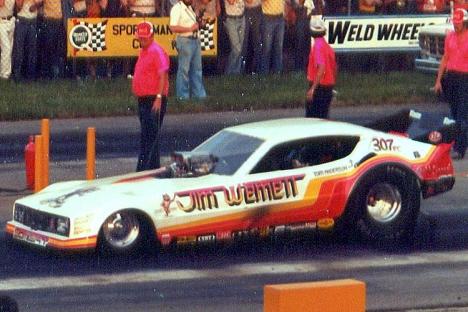By Danny White
In this round of 80s Funny cars, we return to the Northeast and feature the Arrows of R.C. Sherman, Jim Wemett, Tom Gambardella, and Bobby Lagana. The Challengers of Gary Richards and Frank Kramberger are showcased, as are the GM products of Jerry Caminito, Nick Boninfante, and Chuck Etchells, and the lone Ford of Joe Amato. — Updated January 28, 2010
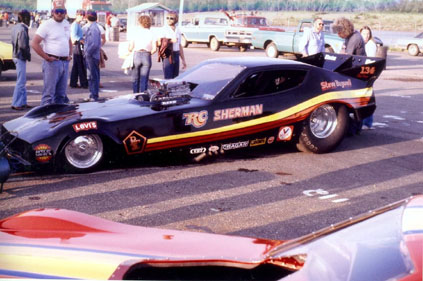
In 1978, when Jim Beattie sold the Black Magic Vega to D.A. Santucci, driver R.C. Sherman built his own AA/FC. Sherman had Ken Cox build this Keith Black-powered Arrow, which he raced from 1978 to 1986. R.C. participated mostly in match race action in the Northeastern United States. The car raced under many banners, including the Dirt Shirt Express, the K-Mart Motivator, Polaroid, and Sherman’s own name. The Arrow’s known best was a 6.29 at 230 MPH in 1980. Due to a lack of funding, R.C. raced the car rarely and could never reach its full potential. (Photo by Big Bob Snyder)
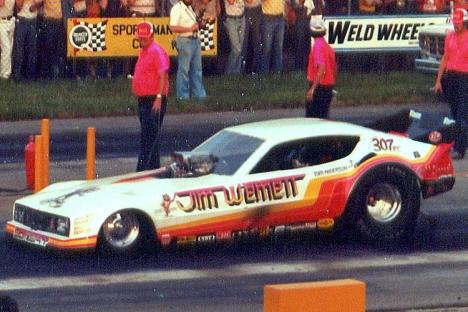
In 1980, Jim Wemett and Tom Anderson teamed up on this Arrow. Wemett had won the 1979 NHRA Division 1 championship with driver George Johnson, while Anderson had been driving the Speed Racer Vega for Mike Kase. The team proved very tough, achieving success in the NHRA, IHRA, and match races. The car ran a known best of 6.16 at 240, according to Draglist files. The Arrow was replaced by the final Speed Racer Omni in 1982, and the team raced together until 1983. (Photo by Mike Beach, courtesy of Curt Swartz)
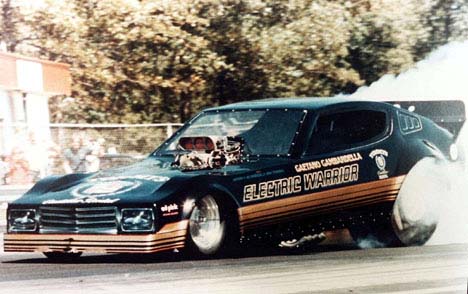
Owner and driver Tom Gambardella debuted the Electric Warrior Arrow in 1979. Tom’s machine was high dollar all the way, featuring a Pat Foster and Jim Hume-built H&H Race Craft chassis and an injector-to-pan Ed Pink Hemi for power. Gambardella painted the car himself, then had it lettered and airbrushed by Glen’s Designs. Tom said that the car’s longer-than-normal headers made it louder than the average funny car. That sound, long burnouts, and a lack of oil downs made it a popular match racer from 1979 to 1984. Gambardella said many minor problems kept the car from reaching its full potential. The car’s best times were 6.92 seconds at 215 mph. The body is still being run today on the old Scarlet Fever TA/FC chassis. (Photo & information courtesy of Tom Gambardella)
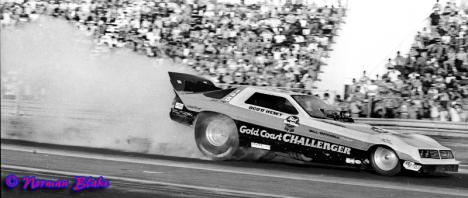
Gary Richards raced several funny cars before building the Gold Coast Challenger. (In fact, Vic Brown won the Summernationals in Richards’ Black Shadow Mustang). Richards used the Gold Coast name originated by Don Nieves, and he tapped Scott Weney to drive. Weney, the son of S&W Race Cars founder Walt Weney, had been driving blown alcohol dragsters and funny cars since the age of 16 and was a perfect fit. Gary and Scott tuned the car to solid middle-of-the-road performances, hitting a known best of 6.10 before parking it. (Photo by Norman Blake)
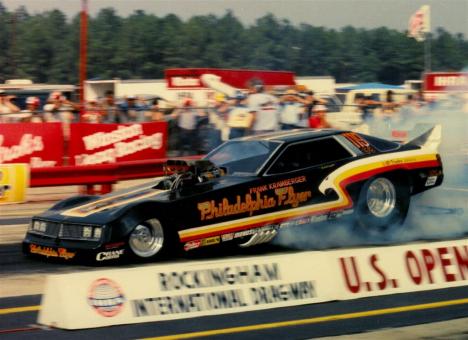
Former Pro Comp racer Frank Kramberger stepped up to fuel funny cars with the Philadelphia Flyer Challenger. Kramberger bought the car and the rights to use the name in the early 80s. Victor Terenzio built the Challenger for the original owner. The car was powered by a standard Keith Black Hemi of the day. Frank raced the car with limited success into the 1985 season when he built a new Thunderbird. Unfortunately, the T-Bird quickly burned to the ground. Kramberger then built a new Mustang that finally achieved long-overdue success. (Photo by Eddie Dale, courtesy of Thomas Nagy)
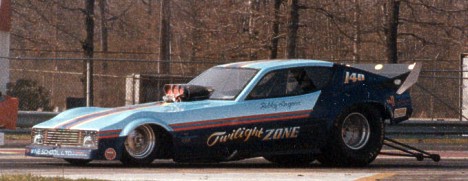
Popular Bob Lagana has raced for decades without big bucks and sponsorship money, but he still does it. In the early eighties, Lagana bought this Arrow from Bob Pickett for match racing action. The car received the beautiful Twilight Zone paint scheme shown here. Bob’s Keith Black Hemi-powered machine was rarely a threat for low ET, but he made solid, consistent runs. Lagana was easy on parts because he had no spares and regularly scrounged for other teams’ trashed parts to continue racing. Bob ran a 6.39, 222 known best in the Arrow. He updated the chassis with a couple of new bodies over the remainder of the decade. Lagana would become known as the last fuel racer to haul a nitro car on an open trailer. He and his sons race in the Top Fuel class to this day. (Photo by Art Cimilluca)
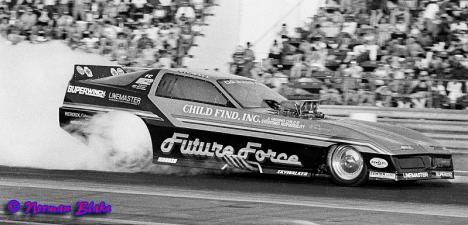
Chuck Etchells was known primarily for match racing before building this Trans Am in 1984. This version of the Future Force brought Etchells national acclaim. Chuck hired recently-retired driver Tom Anderson to tune the car, and Tom put Etchells into the fives. Chuck ran a best of 5.89 at 236 and qualified for several national events. Etchells later burned the car to the ground in a 1985 match race at Englishtown. (Photo by Norman Blake)
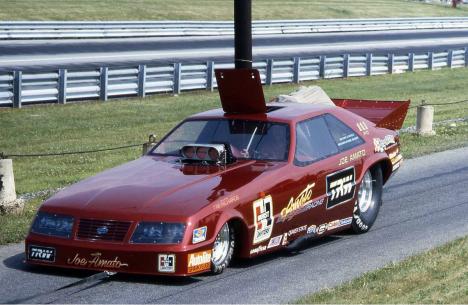
Joe Amato built this super-sano Hurst/TRW-backed Mustang in 1984 to race on the IHRA circuit after the association axed the Top Fuel class. Al Swindahl built the car, and Amato’s famed crew chief Tim Richards built the Keith Back Hemi. Joe ran a 5.80 at 254 at the IHRA Spring Nationals at Bristol. He only raced the car a couple of times in 1984 and 1985 before returning to concentrate solely on his Top Fueler. (Photo by Charlie Carroll)
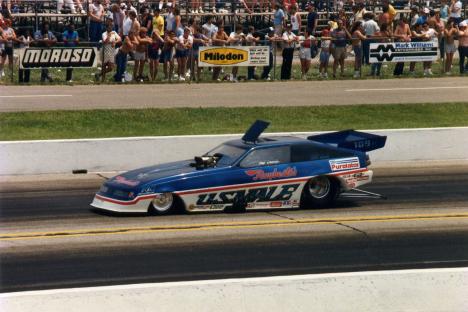
In 1986, Nick Boninfante and his longtime driver Pat Walsh stepped up to AA/FC with a Corvette. They replaced that car in 1987 with this new Keith Black-powered Oldsmobile Firenza. Walsh ran a good 5.70 at 240 in the new U.S. Male machine before stepping out of the seat. Boninfante hired R.C. Sherman to drive, and Raybestos stepped in to sponsor the car. The team became a solid player in NHRA and IHRA national event action. (Photo by Mike Beach, courtesy of Curt Swartz)
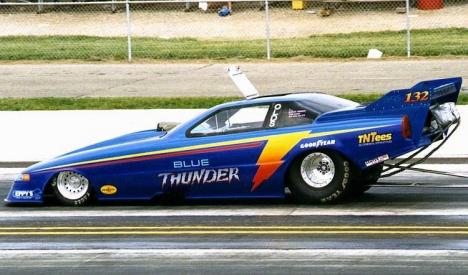
By the end of the decade, longtime funny car racer Jerry Caminito had become one of the best funny car racers in the country. Caminito’s cars were known for their clean appearance, and this Oldsmobile was no different. The beautiful Blue Thunder Cutlass was built by Murf McKinney and powered by a Keith Black Hemi. Although Jerry did not make it to a final round, he finished in the NHRA top ten through solid performances. Caminito ran a best of 5.45 in 1989. (Photo by Mike Beach, courtesy of Curt Swartz)
